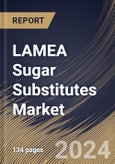Sugar substitutes face unique challenges related to taste, texture, and functionality in the bakery and confectionery. Despite these challenges, manufacturers are actively experimenting with formulations to create sugar-free or low-sugar variants of cakes, cookies, and candies to cater to health-conscious consumers. Sugar contributes sweetness and essential properties like moisture retention, tenderness, and browning in baked goods. Substituting sugar with alternative sweeteners can alter the texture and mouthfeel of products. Maintaining the desired softness in cookies, moistness in cakes, and crispiness in candies without sugar poses a complex challenge.
In addition, the dairy industry has embraced sugar substitutes in producing low-fat and sugar-free versions of yogurt, ice cream, and other frozen desserts. The aim is to provide healthier alternatives without compromising the sweet taste consumers associate with these products. The dairy industry has been significantly influenced by health and wellness trends, which have compelled manufacturers to develop novel products that cater to the tastes of health-conscious consumers.
The UAE has experienced significant growth in its food service sector, with a thriving restaurant and hospitality industry. As more restaurants, cafes, and food establishments cater to diverse consumer preferences, there is a potential demand for sugar substitutes to be incorporated into menu offerings. As per the data given by the Government of Canada, in 2020, the United Arab Emirates was the second-largest foodservice industry in the Arab Gulf Cooperation Council (GCC) region, trailing Saudi Arabia by US$ 13.8 billion. In 2020, foodservice sales through retail constituted the largest channel sector in the UAE, with a food sales value of US$ 4.9 billion, representing 47.2% of the total distribution channel share. Thus, expanding food service and food processing sectors in LAMEA will drive the demand for sugar substitutes in the region.
The Brazil market dominated the LAMEA Sugar Substitutes Market, by Country in 2022, and would continue to be a dominant market till 2030; thereby, achieving a market value of $622.1 Million by 2030. The Argentina market is registering a CAGR of 7.9% during (2023 - 2030). Additionally, The UAE market would showcase a CAGR of 7% during (2023 - 2030).
Based on Application, the market is segmented into Beverages, Food (Bakery & Confectioneries, Dairy, and Others), and Health & Personal Care. Based on Type, the market is segmented into High-intensity Sweeteners, High Fructose Syrup, and Low-intensity Sweeteners. Based on countries, the market is segmented into Brazil, Argentina, UAE, Saudi Arabia, South Africa, Nigeria, and Rest of LAMEA.
List of Key Companies Profiled
- Tate & Lyle Plc.
- Cargill, Incorporated
- Archer Daniels Midland Company
- Ingredion Incorporated
- Roquette Freres SA
- Ajinomoto Co., Inc.
- DuPont de Nemours, Inc.
- Pyure Brands, LLC
- Foodchem International Corporation
- Matsutani Chemical Industry Co., Ltd.
Market Report Segmentation
By Application (Volume, Kilo Tonnes, USD Billion, 2019-2030)- Beverages
- Food
- Bakery & Confectioneries
- Dairy
- Others
- Health & Personal Care
- High-intensity Sweeteners
- High Fructose Syrup
- Low-intensity Sweeteners
- Brazil
- Argentina
- UAE
- Saudi Arabia
- South Africa
- Nigeria
- Rest of LAMEA
Table of Contents
Companies Mentioned
- Tate & Lyle Plc.
- Cargill, Incorporated
- Archer Daniels Midland Company
- Ingredion Incorporated
- Roquette Freres SA
- Ajinomoto Co., Inc.
- DuPont de Nemours, Inc.
- Pyure Brands, LLC
- Foodchem International Corporation
- Matsutani Chemical Industry Co., Ltd.
Methodology

LOADING...








